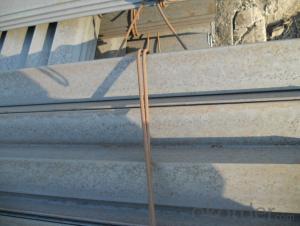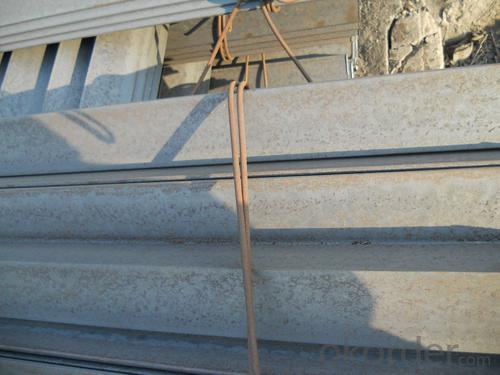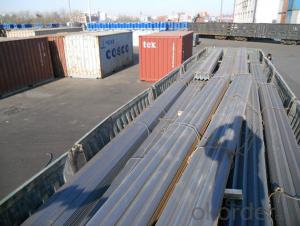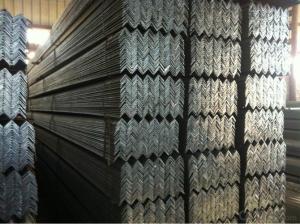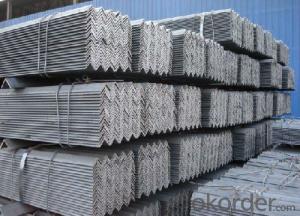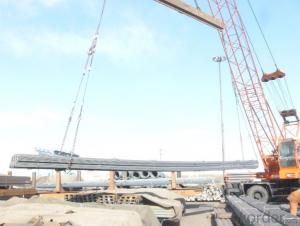Equal Steel Angle with High Quality and Competitive Price
- Loading Port:
- Tianjin
- Payment Terms:
- TT OR LC
- Min Order Qty:
- 25 m.t.
- Supply Capability:
- 20000 m.t./month
OKorder Service Pledge
OKorder Financial Service
You Might Also Like
Specification
Product Description:
OKorder is offering Equal Steel Angle with High Quality and Competitive Price at great prices with worldwide shipping. Our supplier is a world-class manufacturer of steel, with our products utilized the world over. OKorder annually supplies products to European, North American and Asian markets. We provide quotations within 24 hours of receiving an inquiry and guarantee competitive prices.
Product Applications:
Steel Angle Equal Angle with High Quality for Construction are ideal for structural applications and are widely used in the construction of buildings and bridges, and the manufacturing, petrochemical, and transportation industries.
Product Advantages:
OKorder's Steel Angle Equal Angle with High Quality for Construction are durable, strong, and resist corrosion.
Main Product Features:
· Premium quality
· Prompt delivery & seaworthy packing (30 days after receiving deposit)
· Corrosion resistance
· Can be recycled and reused
· Mill test certification
· Professional Service
· Competitive pricing
Packaging & Delivery of Steel Angle Equal Angle with High Quality for Construction:
Packaging Detail: products are packed in bundle and then shipped by container or bulk vessel, deformed bar is usually naked strapping delivery, when storing, please pay attention to moisture proof. The performance of rust will produce adverse effect.
Each bundle weight: 2-3MT, or as required
Payment term: TT or L/C
Delivery Detail: within 45 days after received advanced payment or LC.
Label: to be specified by customer, generally, each bundle has 1-2 labels
Trade terms: FOB, CFR, CIF
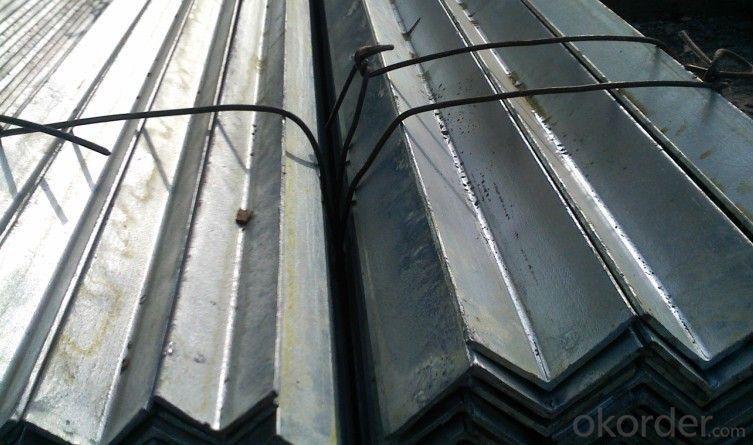
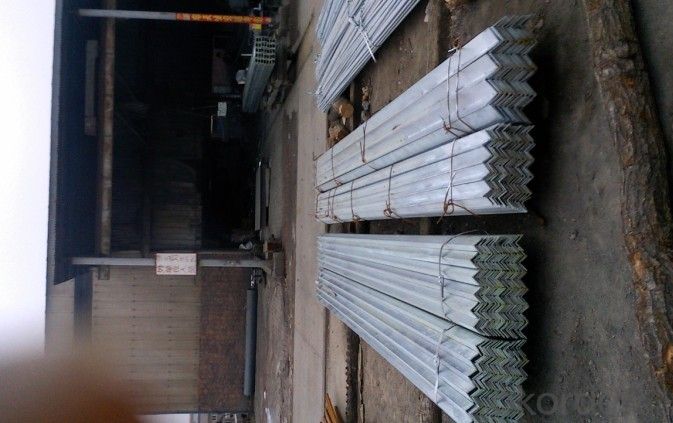
- Q: What are the standard dimensions of steel angles?
- The standard dimensions of steel angles vary depending on the specific type of angle, such as equal or unequal angle. In general, the standard dimensions of steel angles are measured by the length of each leg and the thickness of the material. Equal steel angles typically have equal legs, meaning both sides of the angle are of equal length. The standard dimensions for equal steel angles range from 20mm x 20mm x 3mm to 200mm x 200mm x 24mm. These measurements refer to the length of each leg and the thickness of the angle. Unequal steel angles, on the other hand, have legs of different lengths. The standard dimensions for unequal steel angles range from 40mm x 25mm x 4mm to 200mm x 150mm x 12mm. Again, these measurements indicate the length of each leg and the thickness of the angle. It is important to note that these dimensions are just standard measurements, and custom sizes can also be manufactured based on specific requirements. Additionally, these measurements may vary slightly depending on different steel standards and regional practices.
- Q: Can steel angles be used in the construction of bridges?
- Yes, steel angles can be commonly used in the construction of bridges. Steel angles are versatile structural components that can provide additional strength and support to bridge structures. They are often used in the construction of bridge decks, railings, and supports. Steel angles are known for their high strength-to-weight ratio, which makes them ideal for bridge construction. They can withstand heavy loads and provide stability to the bridge structure. Additionally, steel angles are durable and resistant to corrosion, which is essential for bridges that are exposed to various environmental conditions. In bridge construction, steel angles are often used in conjunction with other steel components, such as beams and columns, to create a strong and reliable structure. They are commonly used as bracing elements to reinforce the overall stability of the bridge. Steel angles can also be used as connection elements, allowing different parts of the bridge to be securely joined together. Overall, steel angles are a crucial component in bridge construction, providing strength, durability, and stability to the structure. Their versatility and reliability make them a preferred choice for engineers and designers when constructing bridges of various sizes and types.
- Q: How do you determine the axial capacity of a steel angle?
- In order to ascertain the axial capacity of a steel angle, one must consider several factors. First and foremost, it is crucial to determine the yield strength of the steel angle. Typically, this information is provided by the manufacturer and can be found in material specifications. The yield strength denotes the maximum stress that the steel angle can endure without experiencing permanent deformation. Following that, the cross-sectional area of the steel angle must be computed. This can be achieved by measuring the angle's dimensions, such as the thickness and the length of its legs. The cross-sectional area is then obtained by multiplying the thickness by the sum of the two leg lengths. Once the cross-sectional area is ascertained, the axial capacity can be calculated by multiplying the yield strength by the cross-sectional area. This will determine the maximum load that the steel angle can bear in a purely axial direction without failure. It is important to bear in mind that there are additional factors that can impact the axial capacity of a steel angle, including the presence of holes or notches, the slenderness ratio, and the loading conditions. Therefore, it is advisable to consult relevant design codes, standards, or engineering handbooks for more comprehensive guidance and to account for these supplementary factors.
- Q: How do you prevent rust on steel angles?
- One way to prevent rust on steel angles is by applying a protective coating or paint that acts as a barrier against moisture and oxygen. Additionally, keeping the steel angles dry and storing them in a controlled environment with low humidity can help prevent rust formation. Regular inspections and maintenance, such as cleaning and removing any dirt or corrosion, can also help in preventing rust on steel angles.
- Q: What is 4# angle iron? What are the classifications of angle iron? What are the specifications? Thank you
- Angle called angle, the steel strip is perpendicular to each other on both sides into the corner. There are equal angles and unequal angles. The two sides of an equal angle steel are equal in width. The specifications are expressed in millimeters of edge width * edge width * edge thickness. Such as "/ 30 x 30 x 3", that is 30 mm width equal angle, edge thickness of 3 mm. Also available models that model is the number of centimeters wide, such as angle 3#. The model does not mean the size of the different edges and sizes of the same model. Therefore, the width, the edge and the thickness of the angle iron should be filled out in the contract and other documents, so as not to be indicated by the model alone. Standard Specification for hot-rolled equal angle iron is 2#-20#. The angle iron can be made up of different force components according to the different structure, and can also be used as the connecting piece between the components. Widely used in a variety of architectural and engineering structures, such as beams, bridges, towers, hoisting and conveying machinery, ships, industrial furnace, reaction tower, container frame and warehouse.
- Q: How do you specify steel angles in a construction project?
- In a construction project, steel angles are typically specified by indicating the dimensions of the angle and the type of steel used. This includes specifying the length and width of the angle, as well as the thickness of the steel. Additionally, the type of steel, such as A36 or A572, may be specified to ensure the desired strength and durability.
- Q: 304 what does angle iron stand for?
- 304 stainless steel, consisting of 18Cr-9Ni, is the most widely used stainless steel and heat resistant steel. Used in food production equipment, chemical equipment, nuclear energy, etc..
- Q: What are the different methods for fastening steel angles?
- Fastening steel angles can be done in several ways, depending on the specific application and load requirements. Some commonly used methods include the following: 1. Bolting: Bolting is a popular method for securing steel angles. It involves using bolts, washers, and nuts to attach the angle to a structure or another piece of steel. This method provides a strong and dependable connection, especially when the bolts are tightened to the correct torque specification. 2. Welding: Welding is another commonly employed technique for fastening steel angles, particularly when a permanent and sturdy connection is necessary. It entails melting the base metal and the angle together to form a robust joint. Various welding techniques, such as arc welding, MIG welding, or TIG welding, can be utilized. 3. Riveting: Riveting is a method that involves using rivets to join steel angles together or to other components. This approach creates a secure and durable connection, especially in situations where there may be vibration or movement. Riveting requires drilling holes in the steel angles and using a rivet gun to insert the rivets through the holes. 4. Adhesive bonding: Adhesive bonding can be employed in certain applications to fasten steel angles. This method involves applying a high-strength adhesive or epoxy between the angle and the surface to which it is being attached. Adhesive bonding offers a clean and visually appealing connection while also evenly distributing loads across the joint. 5. Clamping: Clamping is a temporary method used to hold steel angles in place during assembly or construction. It involves using clamps or brackets until a more permanent fastening method, such as bolting or welding, can be applied. Each method has its own advantages and disadvantages, and the choice depends on factors such as load requirements, structural design, cost, and the need for disassembly or adjustability. Selecting the appropriate fastening method is crucial to ensure the safety and integrity of the steel angles in their intended application.
- Q: What are the benefits of using hot-rolled steel angles?
- Hot-rolled steel angles offer numerous advantages in diverse applications. To begin, their notable strength and durability are well-known. This is achieved through the hot-rolling process, which involves heating the steel above its recrystallization temperature and shaping it accordingly. Consequently, hot-rolled steel angles possess superior strength compared to their cold-rolled counterparts, rendering them ideal for structural applications that require robust load-bearing capacity. Moreover, hot-rolled steel angles exhibit exceptional weldability. The high temperatures endured during the hot-rolling process refine the steel's grain structure, making it easier to weld. This characteristic proves particularly beneficial in construction projects where the seamless joining of steel angles is crucial for creating a variety of structures. In addition, hot-rolled steel angles boast a flawless surface finish. The hot-rolling process effectively eliminates surface defects and impurities, resulting in a clean and polished appearance. This aesthetic appeal makes hot-rolled steel angles suitable for architectural and decorative purposes. Furthermore, hot-rolled steel angles offer cost-effectiveness. The efficiency and affordability of the hot-rolling process surpass those of alternative manufacturing methods, such as cold-rolling. As a result, hot-rolled steel angles are more budget-friendly, providing an advantage for cost-conscious projects. Lastly, hot-rolled steel angles are readily available in an extensive range of sizes and dimensions. This versatility allows for greater flexibility in design and construction applications. Regardless of whether the project is residential, commercial, or industrial in nature, the availability of various sizes ensures that hot-rolled steel angles can be easily incorporated. Overall, the multiple benefits of hot-rolled steel angles encompass their high strength, excellent weldability, smooth surface finish, cost-effectiveness, and availability in diverse sizes. These qualities contribute to the popularity of hot-rolled steel angles across various industries and applications.
- Q: What are the different types of steel angles used in automotive engineering?
- In automotive engineering, there are several types of steel angles that are commonly used. These angles play a crucial role in providing structural strength, improving stability, and enhancing the overall performance and safety of vehicles. Here are some of the different types of steel angles used in automotive engineering: 1. L-angles: L-angles, also known as unequal angles, are often used in automotive engineering to provide structural support and reinforcement. These angles have different lengths on each side, allowing them to be easily welded or bolted onto various components of a vehicle's chassis or frame. 2. T-angles: T-angles, also known as tee angles, are frequently used in automotive engineering to join two components together at a right angle. These angles are designed with a flat base and a vertical stem, which enables them to provide stability and hold different parts of a vehicle securely in place. 3. C-angles: C-angles, also known as channel angles, are commonly utilized in automotive engineering to form the framework for various vehicle structures. These angles have a U-shaped cross-section and are often used to create structural components like door frames, roof rails, and chassis reinforcements. 4. Z-angles: Z-angles, also known as Z-bar angles, are widely employed in automotive engineering to provide strength and rigidity to different vehicle structures. These angles have a Z-shaped cross-section, which allows them to resist bending and torsional forces effectively. Z-angles are often used in applications such as suspension systems, roll bars, and body components. 5. U-angles: U-angles, also known as U-bar angles, are commonly used in automotive engineering to provide support and reinforcement to various vehicle components. These angles have a U-shaped cross-section and are frequently utilized to create structural members like bumper beams, frame reinforcements, and roll cage bars. These are just a few examples of the different types of steel angles used in automotive engineering. Each angle has its own unique properties and applications, and their selection depends on the specific requirements of the vehicle design and the desired structural integrity.
Send your message to us
Equal Steel Angle with High Quality and Competitive Price
- Loading Port:
- Tianjin
- Payment Terms:
- TT OR LC
- Min Order Qty:
- 25 m.t.
- Supply Capability:
- 20000 m.t./month
OKorder Service Pledge
OKorder Financial Service
Similar products
Hot products
Hot Searches
Related keywords
